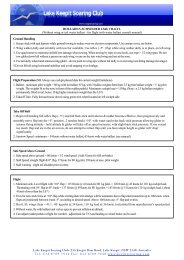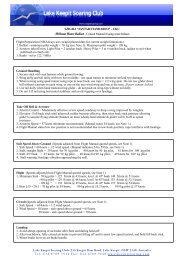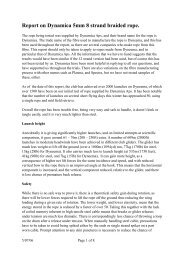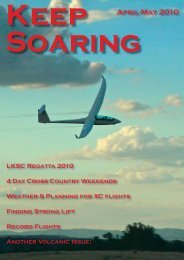Flying the Morning Glory Dust Devil Dash Hitting the Silk New ...
Flying the Morning Glory Dust Devil Dash Hitting the Silk New ...
Flying the Morning Glory Dust Devil Dash Hitting the Silk New ...
Create successful ePaper yourself
Turn your PDF publications into a flip-book with our unique Google optimized e-Paper software.
<strong>Hitting</strong> <strong>the</strong> <strong>Silk</strong><br />
The Right Gear for You.<br />
The US are currently changing <strong>the</strong>ir military parachutes. Soldiers<br />
are carrying more gear so <strong>the</strong>ir parachutes have to be made larger.<br />
Oddly, <strong>the</strong> new version cannot be steered, perhaps this is to optimise<br />
<strong>the</strong> sink rate.<br />
Parachutes have to be loaded correctly so <strong>the</strong>y descend at <strong>the</strong> right<br />
speed to work properly. When people like sky divers and paraglider<br />
pilots throw a back-up parachute while <strong>the</strong>ir main chute is up, <strong>the</strong> area<br />
increases, but <strong>the</strong> sink rate is higher, not lower.<br />
The size of parachute you carry really should be a function of your<br />
age as well as your weight! How fast do you want to fall, and how<br />
quickly do you want <strong>the</strong> chute to open? We all want <strong>the</strong> fastest opening<br />
possible, but fast opening means a small area chute. While a 20 year old<br />
may be able to jump down from a 3-4 metre high wall without injury, a<br />
50 year old cannot expect to do this without being hurt.<br />
In fact, this is one reason why <strong>the</strong> idea of doing parachute practice<br />
jumps may not be so good for many pilots. The chances are that some<br />
injury is going to result in any case, so why bo<strong>the</strong>r?<br />
We are not interested in <strong>the</strong> opening time of a parachute. We are<br />
interested in distance. If you are 50 metres above <strong>the</strong> ground, you<br />
don’t care if your parachute opens in one or two or three seconds, you<br />
care that it opens in 45 metres or 55 metres. The opening distance, all<br />
things being equal, is a function of <strong>the</strong> size of <strong>the</strong> parachute. A small<br />
parachute will open in a shorter distance than a large one.<br />
Sailplane pilots need a parachute which is rated to open at high<br />
speed. This is quite different to a hang glider pilot who will deploy<br />
a parachute at a low descent speed. A parachute which is deployed<br />
at high speed has to be strong to withstand <strong>the</strong> opening shock.<br />
Sometimes <strong>the</strong> opening sequence is staged or delayed to reduce<br />
<strong>the</strong> opening shock at high speed which has <strong>the</strong> undesirable affect of<br />
increasing <strong>the</strong> opening distance.<br />
The opening distance is almost precisely a function of <strong>the</strong> opening<br />
time squared, i.e. doubling <strong>the</strong> opening time requires basically 4x <strong>the</strong><br />
opening distance. A human operated parachute may open in 2.5 - 3<br />
seconds, a ballistic parachute is required in Germany to operate in 4.5<br />
seconds… although designers think that 5 seconds is more practical.<br />
So if you are ridge soaring or flying in <strong>the</strong> mountains, don’t rely on<br />
your ballistic parachute!<br />
It is possible to improve (i.e. reduce) <strong>the</strong> sink-rate for a parachute<br />
of a given size by designing it with <strong>the</strong> highest possible aerodynamic<br />
drag coefficient. However, to obtain a better sink-rate for <strong>the</strong> same<br />
pilot weight on <strong>the</strong> same model parachute, <strong>the</strong> only possibility is to<br />
use a larger size parachute.<br />
October November 2009<br />
A seemingly obvious choice made by many, however, a larger<br />
size requires a greater opening distance, more weight, more<br />
volume, greater encumbrance to extract from <strong>the</strong> container and<br />
a higher price. A larger size of <strong>the</strong> same design has longer lines<br />
and requires a larger volume of air for inflation: at high speed <strong>the</strong><br />
vertical opening distance required by a parachute is related to <strong>the</strong><br />
square root of <strong>the</strong> surface area (doubling <strong>the</strong> surface area increases<br />
1.41 times <strong>the</strong> opening distance).<br />
The controversy over sink-rate is essentially a philosophical<br />
problem: Alain Zoller - Swiss Federation test pilot - with considerable<br />
experience deploying parachutes in simulated accidents, prefers a<br />
good sink-rate, while Andy Hediger - renowned Paratech test pilot -<br />
who has performed at least 5 deployments in real accidents, prefers<br />
flying with a parachute which opens fast. To allow everyone to<br />
decide for <strong>the</strong>mselves, pilots must be clearly informed what sinkrate<br />
<strong>the</strong>y will get with <strong>the</strong>ir weight on a particular make and model<br />
of parachute, very carefully remembering that what is acceptable<br />
for a young karate champion would be totally inappropriate for an<br />
elderly pilot in average physical condition.<br />
Primary Safety<br />
There is absolutely no doubt that primary safety is better than<br />
secondary safety. If you don’t get yourself into a position where you<br />
will need to deploy a parachute, <strong>the</strong>n you will not need to worry<br />
about whe<strong>the</strong>r your parachute will open. Primary safety should<br />
always be our priority over secondary safety. In almost all instances,<br />
having to bail out of a glider can be avoided.<br />
Mid-air collisions suggest that at least one person was not<br />
keeping a proper look out.<br />
Control failures suggest that servicing, rigging and DI-ing was<br />
not done properly.<br />
Structural failures due to over stressing <strong>the</strong> aircraft are rare,<br />
and in many cases have elements of pilot error.<br />
Perhaps <strong>the</strong> Professor it right from <strong>the</strong> start. We should all make<br />
sure that we have absolutely no need to throw a parachute!<br />
The text of this article comes from a variety of sources<br />
including Angelo Crapanzano of Metamorfosi, <strong>the</strong> PA (Parachutes<br />
Australia) manual for <strong>the</strong> slimpack emergency parachute, DG<br />
Flugzuegbau, Drop Zone and o<strong>the</strong>rs.<br />
Keep Soaring October-November 2009 Page 34








